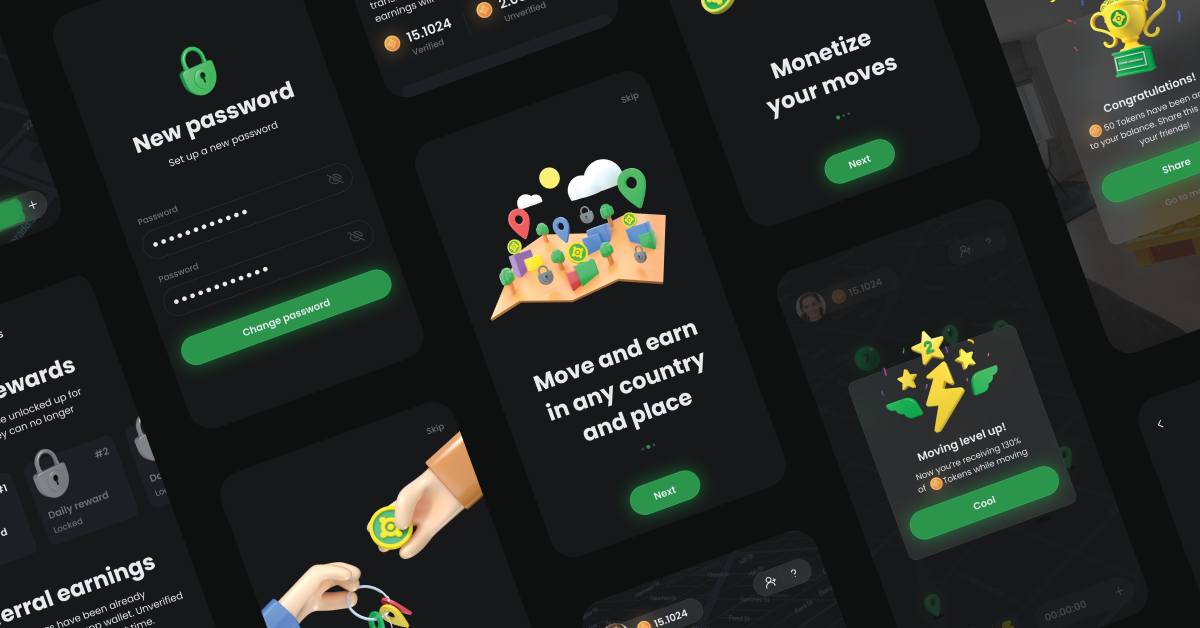Trends
The Potential of AR in Web Design
Unlocking the potential of WebAR — how augmented and virtual realities may change the web design industry and who will benefit from the implementation of these technologies.

Augmented Reality Concept
Augmented reality has become increasingly popular and now almost everyone is aware of its features and benefits. The term “AR” dates back to the early 1990s. Then airline pilots used it to facilitate navigation. In 2021, it is evolving fast and moving into the field of web design.
AR adds virtual objects to the real setting through smart devices. These digital objects are amplified by computer-generated visual info. The technology lets augmentation be overlaid on real panorama — a dinosaur might be seen running in the woods, the cats could be playing with their cartoon counterparts, and so on.
It seems that the most known AR representative is Pokemon Go — this application has become a sensation just in several months. However, there are lots of options to enjoy AR advantages in the everyday life.
Here are some examples:
● Ground crews at some airports wear AR glasses to check cargo containers. It helps to speed uploading.
● Football broadcasters use technology to analyze games.
● Furniture stores offer an AR app to let their potential customers see how a certain piece will fit in their apartment.
● Doctors use 3-D brain projections for surgeries.
● Ancient civilizations over today’s ruins are viewed using AR, enhancing the whole tourism industry.
● Different enterprises (from tiny factories to huge malls and plants) create virtual tours for investors and visitors. This approach enhances business opportunities, helps to seem transparent and trustworthy to potential partners and customers strengthens relations with clients, and even lets new employees get ready for a new job online and interactively. Here’s one of our VR projects — a virtual tour for a manufacturing company.
Is Augmented Reality the Future of Web Design?
AR challenges designers and developers, anyway, it’s worth that because there is a huge potential for augmented reality in web design. Currently, it is implemented into lots of apps related to diverse fields and is already transforming the industry. Regardless, the best AR level and features are yet to be developed.
Soon, we may not even use mobile apps or glasses to enjoy AR benefits but unfortunately, there still exist some cool ideas that can’t be implemented with browser-based AR right now. Augmented reality uses a webcam for a view of the user’s setting. Depending on the platform being used, it applies image recognition to display graphics on different objects, for example, sunglasses and dresses.

The mobile version of augmented reality is a bit more complex — smartphones deal with GPS, applications, sensors, and compasses at the same time in order to display images of real objects. This works great in the field of tourism. Such apps let users point their smartphones at some landmarks and thus uncover hidden info and enjoy virtual visits of places with zero access.
AR Impact on UX
Almost 5 years ago Forbes predicted that mobile AR/VR would be a whole business. Since then, designers have been searching for options to enhance AR/VR breathtaking content. For instance, Google VR view gives designers an opportunity to apply 360-degree video to their websites, and those who use mobile-optimized websites, get much better UX and organic search results.
The biggest change in the industry is related to the mobile version. This is especially evident in web design because we are shifting from static, non-changing websites to engaging ones, where content is changing all the time and is provided with 36- degree panorama. It gives designers interaction with their clients, placing key data all around — instead of opening lots of tabs in a single 2D screen, users can see all the info around them in an organized way, just like a chemist sees and can reach all the needed components in his lab. There’s one more huge advantage of this approach — just as YouTube’s recommender system, AR uses analytical tools to understand consumers and forecast their interests. Instead of providing typical content, augmented reality captures contextual data and provides the best-personalized content.


How Augmented and Virtual Realities May Change Web Design
AR and VR are complementary in UX improvement. The most valuable VR advantage is that it extends the projects’ reach — if you’re a business consultant you can set up VR calls with a client and offer tutorials right from your house or office. All you need is to add 3D modeling to your website and provide your services.
Moreover, VR makes browsers immersive, personalized, and tangible. For example, you can skip saving shoes on Instagram and go virtual shopping by visiting all your favorite shops filled with diverse shoes of the needed brands, trying them on (with the help of avatars), and getting them delivered in a few days. That’s it. Such an approach gives limitless options and may change almost every industry.
Nevertheless, VR and AR have their skeptics who are assured that these technologies won’t hit the mainstream and that augmented and virtual reality web design will be a waste of money. At Phenomenon Studio, we don’t think so consider the following:
● In 2021, Streetview by Google lets us embed and promote VR media on any website. It shows up in organic search results, so potential customers interact with it through their smartphones or computers. More than that, when it comes to proper mobile optimization, 360-degree websites load really fast and provide breathtaking experiences without any VR headsets.
● VR implementation increases visitor engagement and enhances user behavior indicators, especially time spent on a website.
● Right now developers and designers are implementing compatible plug-ins. Speaking of WordPress VR View, users can upload virtual reality videos onto their WordPress website.
For our team of designers, it’s evident that both VR and AR will catch on in web design. You don’t even need a special headset to enjoy these modern technologies and apply them to your app or website — just take a look at AR mobile app we designed for our client.
Unlocking the Potential of AR Web Design
AR is now ready to be implemented on applications and websites of almost all shapes and sizes while more and more users are getting access to take advantage of AR’s power using both headsets and customized mobile interfaces.
However, AR implementation can be challenging for designers when it comes to user experience. For example, adding too much information and interactive features to a single app or site can scare customers off.
Therefore, web designers study brand-new tools and follow the “customers first” concept. If this approach gets widespread there will be an opportunity to make considerable advances in AR web design.
Interesting Ways in which AR Can Enhance Web Design
Being implemented into websites and apps, WebAR hugely enhances web design, mainly due to its multiple advantages.
Here are some of them:
- AR improves UX in both desktop and mobile versions.
- Easy sharing (URL shareability) is one of the key WebAR benefits and the chances of sharing WebAR content are impressive. Such content works as all marketing links (display ads, social media, messaging, etc.)
- Less memory is needed for WebAR — no special apps are required and a simple browser is enough.
- AR apps can be used in web design as compatible plugins. Such plugins are available for all business owners to enhance their web projects by uploading high-quality AR videos to the sites.
- Easy access to analytics. Marketing analytics setup is rather simple for WebAR and provides all the basic statistics.
- WebAR designers can take advantage of phone cameras and webcams to put AR into action and further encourage potential customers to interact with their services or products.
- Cross-platform helps users feel augmented reality features by using their favorite browser on any modern device.
Conclusion
More and more online businesses are adopting WebAR and it will transform marketing techniques a lot. Founders will be able to communicate with potential clients directly in a powerful and interactive way. You don’t have to be a billionaire to implement WebAR — AR offers easier deployment with lower costs. Even small online stores will efficiently reach users and provide high-quality service from their websites.
Both businesses and users will benefit from this technology and it’s high time to implement it. The Phenomenon team generates unique decisions and catches WebAR design when working on your projects. We are respected for our approach to work, which is reflected in each case. Check, how Phenomenon Studio has implemented AR in one of the clients’ mobile apps on our Dribbble.
Read more articles by Phenomenon Studio on Medium:
MindTales: How to Ensure Emotional Well-Being with Mobile Design
Welcome to check projects by Phenomenon Studio Dribbble and Behance
Let’s get in touch: hello@phenomenon-studio.com
